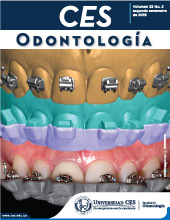Cervical Extraoral Traction Therapy in Early Treatment of Class II Malocclusion. A systematic review
DOI:
https://doi.org/10.21615/cesodon.32.2.2Keywords:
cervical extraoral traction, class II malocclusion, early treatmentAbstract
Introduction and objective: Cervical headgear has been used for decades as a treatment of class II malocclusion. Although the effects have been reported previously they are somewhat contradictory. The objective was to determine the available scientific evidence that supports the parameters of clinical use for therapy with cervical extraoral traction in early treatment for class II malocclusion. Materials and methods: A systematic search was conducted using Medline, Google Scholar, Cochrane, and Lilacs databases. The search involved articles in English, Spanish, Portuguese, and German using previously selected MeSH terms and free-text terms. The search included articles dealing with cervical extraoral traction treatment, systematic reviews, meta-analysis, clinical trials, and cohort, case-control, and cross-sectional studies. Methodological quality was evaluated using various scales according to the type of study. Results: The search generated 334 articles, 259 were eliminated because they were duplicates, and 34 were eliminated because they did not meet the inclusion criteria. 41 articles were evaluated in full text, 21 were excluded because they did not meet the inclusion criteria, leaving a total of 20 articles. Conclusions: The articles offered varied, yet clear, recommendations. According to the literature and clinical judgment, treatment timing is recommended during the pubertal growth spurt. The most efficient force is 450 to 500g per side for 12 to 14 hours per day. A long outer bow bent 15o degrees upward should be used in patients with normal and hypodivergent patterns. Maxillary growth control depends on age, force, treatment duration, etc. Changes in overjet can be expected due to changes in dental inclination, growth, or the use of additional appliances; an average molar distalization of 1 mm to 2 mm can be achieved.
Downloads
References
Melsen B, Enemark H. Effect of cervical anchorage studied by the implant method. Rep Congr Eur Orthod Soc. 1969;435–447.
Wieslander L. The effect of force on craniofacial development. Am J Orthod. 1974 May;65(5):531–538.
Baumrind S, Molthen R, West EE, Miller DM. Mandibular plane changes during maxillary retraction. Am J Orthod. 1978;74(1):32–40.
Melsen B. Effects of cervical anchorage during and after treatment: an implant study. Am J Orthod. 197873(5):526–540.
Tulloch JF, Proffit WR, Phillips C. Influences on the outcome of early treatment for Class II malocclusion. Am J Orthod Dentofac Orthop Off Publ Am Assoc Orthod Its Const Soc Am Board Orthod. 1997111(5):533–542.
Tulloch JF, Phillips C, Proffit WR. Benefit of early Class II treatment: progress report of a two-phase randomized clinical trial. Am J Orthod Dentofac Orthop Off Publ Am Assoc Orthod Its Const Soc Am Board Orthod. 1998;113(1):62–72, quiz
–74.
Kirjavainen M, Kirjavainen T, Hurmerinta K, Haavikko K. Orthopedic cervical headgear with an expanded inner bow in class II correction. Angle Orthod. 2000;70(4):317–325.
Henriques FP, Janson G, Henriques JFC, Pupulim DC. Effects of cervical headgear appliance: a systematic review. Dent Press J Orthod. 2015;20(4):76–81.
Pirttiniemi P, Kantomaa T, Mäntysaari R, Pykäläinen A, Krusinskiene V, Laitala T, et al. The effects of early headgear treatment on dental arches and craniofacial morphology: an 8 year report of a randomized study. Eur J Orthod. 2005;27(5):429–436.
Papageorgiou SN, Kutschera E, Memmert S, Gölz L, Jäger A, Bourauel C, et al. Effectiveness of early orthopaedic treatment with headgear: a systematic review and meta-analysis. Eur J Orthod. 2017;39(2):176–187.
Baumrind S, Korn EL, Isaacson RJ, West EE, Molthen R. Quantitative analysis of the orthodontic and orthopedic effects of maxillary traction. Am J Orthod. 1983;84(5):384–398.
Hubbard GW, Nanda RS, Currier GF. A cephalometric evaluation of nonextraction cervical headgear treatment in Class II malocclusions. Angle Orthod. 1994;64(5):359–370.
Keeling SD, Wheeler TT, King GJ, Garvan CW, Cohen DA, Cabassa S, et al. Anteroposterior skeletal and dental changes after early Class II treatment with bionators and headgear. Am J Orthod Dentofac Orthop Off Publ Am Assoc Orthod Its Const Soc Am Board Orthod. 1998;113(1):40–50.
Ulger G, Arun T, Sayinsu K, Isik F. The role of cervical headgear and lower utility arch in the control of the vertical dimension. Am J Orthod Dentofac Orthop Off Publ Am Assoc Orthod Its Const Soc Am Board Orthod. 2006;130(4):492–501.
Higgins J, Green S. .Manual Cochrane de revisiones sistemáticas de intervenciones. versión 5.1.0. Oxford; 2011.
Jadad AR, Moore RA, Carroll D, Jenkinson C, Reynolds DJ, Gavaghan DJ, et al. Assessing the quality of reports of randomized clinical trials: is blinding necessary? Control Clin Trials. 1996;17(1):1–12.
Shea BJ, Bouter LM, Peterson J, Boers M, Andersson N, Ortiz Z, et al. External validation of a measurement tool to assess systematic reviews (AMSTAR). PLoS ONE. 2007;2(12):e1350.
Berra S, Elorza-Ricart JM, Estrada M-D, Sánchez E. [A tool (corrected) for the critical appraisal of epidemiological cross-sectional studies]. Gac Sanit SESPAS. 2008 ;22(5):492–497.
Alió-Sanz J, Iglesias-Conde C, Lorenzo-Pernía J, Iglesias-Linares A, Mendoza-Mendoza A, Solano-Reina E. Effects on the maxilla and cranial base caused by cervical headgear: a longitudinal study. Med Oral Patol Oral Cirugía Bucal. 2012;17(5):e845–851.
Bondemark L, Karlsson I. Extraoral vs intraoral appliance for distal movement of maxillary first molars: a randomized controlled trial. Angle Orthod. 2005;75(5):699–706.
Godt A, Kalwitzki M, Göz G. Retrospective analysis of casts to assess cervical headgear treatment in the presence of vertical growth pattern. J Orofac Orthop Fortschritte Kieferorthopädie OrganOfficial J Dtsch Ges Für Kieferorthopädie. 2005;66(3):230–240.
Godt A, Kalwitzki M, Göz G. Effects of cervical headgear on overbite against the background of existing growth patterns. A retrospective analysis of study casts. Angle Orthod. 2007;77(1):42–46.
Godt A, Berneburg M, Kalwitzki M, Göz G. Cephalometric analysis of molar and anterior tooth movement during cervical headgear treatment in relation to growth patterns. J Orofac Orthop Fortschritte Kieferorthopädie OrganOfficial J Dtsch Ges Für Kieferorthopädie. 2008;69(3):189–200.
Kirjavainen M, Kirjavainen T, Haavikko K. Changes in dental arch dimensions by use of an orthopedic cervical headgear in Class II correction. Am J Orthod Dentofac Orthop Off Publ Am Assoc Orthod Its Const Soc Am Board Orthod. 1997;111(1):59–66.
Kirjavainen M, Kirjavainen T. Maxillary expansion in Class II correction with orthopedic cervical headgear. A posteroanterior cephalometric study. Angle Orthod. 2003;73(3):281–285.
Kirjavainen M, Hurmerinta K, Kirjavainen T. Facial profile changes in early Class II correction with cervical headgear. Angle Orthod. 2007;77(6):960–967.
Kopecky GR, Fishman LS. Timing of cervical headgear treatment based on skeletal maturation. Am J Orthod Dentofac Orthop Off Publ Am Assoc Orthod Its Const Soc Am Board Orthod. 1993;104(2):162–169.
Lima Filho RMA, Lima AL, de Oliveira Ruellas AC. Mandibular changes in skeletal class II patients treated with Kloehn cervical headgear. Am J Orthod Dentofac Orthop Off Publ Am Assoc Orthod Its Const Soc Am Board Orthod. 2003;124(1):83–90.
Lima Filho RMA, Lima AL, de Oliveira Ruellas AC. Longitudinal study of anteroposterior and vertical maxillary changes in skeletal class II patients treated with Kloehn cervical headgear. Angle Orthod. 2003;73(2):187–193.
Lione R, Franchi L, Laganà G, Cozza P. Effects of cervical headgear and pendulum appliance on vertical dimension in growing subjects: a retrospective controlled clinical trial. Eur J Orthod. 2015;37(3):338–344.
Mäntysaari R, Kantomaa T, Pirttiniemi P, Pykäläinen A. The effects of early headgear treatment on dental arches and craniofacial morphology: a report of a 2 year randomized study. Eur J Orthod. 2004;26(1):59–64.
Melsen B, Dalstra M. Distal molar movement with Kloehn headgear: is it stable? Am J Orthod Dentofac Orthop Off Publ Am Assoc Orthod Its Const Soc Am Board Orthod. 2003;123(4):374–378.
Varlik SK, Iscan HN. The effects of cervical headgear with an expanded inner bow in the permanent dentition. Eur J Orthod. 2008;30(4):425–430.
Kloehn SJ. Evaluation Of Cervical Anchorage Force In Treatment. Angle Orthod. 1961;31(2):91–104.
King EW. Cervical Anchorage in Class II, Division I Treatment, A Cephalometric Appraisal. Angle Orthod. 1957;27(2):98–104.
Tulloch JF, Phillips C, Koch G, Proffit WR. The effect of early intervention on skeletal pattern in Class II malocclusion: a randomized clinical trial. Am J Orthod Dentofac Orthop Off Publ Am Assoc Orthod Its Const Soc Am Board Orthod.
;111(4):391–400.
Hunter CJ. The correlation of facial growth with body height and skeletal maturation at adolescence. Angle Orthod. 1966;36(1):44–54.
Yepes E, Quintero P, Rueda ZV, Pedroza A. Optimal force for maxillary protraction facemask therapy in the early treatment of class III malocclusion. Eur J Orthod. 2014;36(5):586–594.
Cook AH, Sellke TA, BeGole EA. Control of the vertical dimension in Class II correction using a cervical headgear and lower utility arch in growing patients. Part I. Am J Orthod Dentofac Orthop Off Publ Am Assoc Orthod Its Const Soc Am
Board Orthod. 1994;106(4):376–388.
Brown P. A cephalometric evaluation of high-pull molar headgear and face-bow neck strap therapy. Am J Orthod. 1978;74(6):621–632.
Boecler PR, Riolo ML, Keeling SD, TenHave TR. Skeletal changes associated with extraoral appliance therapy: an evaluation of 200 consecutively treated cases. Angle Orthod. 1989;59(4):263–270.
Boatwright P. Single arch treatment with the Kloehn headgear: A cephalometric evaluation. [unpublished Master’s Thesis]. Department of Orthodontics, St. Louis University;; 1968.
Cangialosi TJ, Meistrell ME, Leung MA, Ko JY. A cephalometric appraisal of edgewise Class II nonextraction treatment with extraoral force. Am J Orthod Dentofac Orthop Off Publ Am Assoc Orthod Its Const Soc Am Board Orthod. 1988;93(4):315–324.
Ghafari J, Shofer FS, Jacobsson-Hunt U, Markowitz DL, Laster LL. Headgear versus function regulator in the early treatment of Class II, division 1 malocclusion: a randomized clinical trial. Am J Orthod Dentofac Orthop Off Publ Am Assoc
Orthod Its Const Soc Am Board Orthod. 1998;113(1):51–61.
Downloads
Published
How to Cite
Issue
Section
License
Copyright (c) 2019 CES Odontología

This work is licensed under a Creative Commons Attribution-NonCommercial-ShareAlike 4.0 International License.
| Article metrics | |
|---|---|
| Abstract views | |
| Galley vies | |
| PDF Views | |
| HTML views | |
| Other views | |



